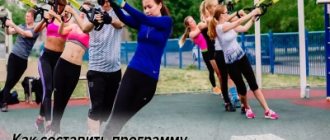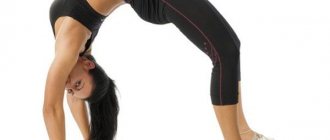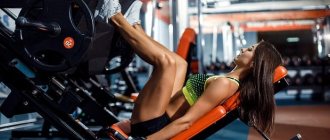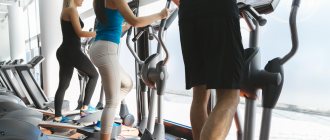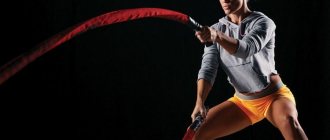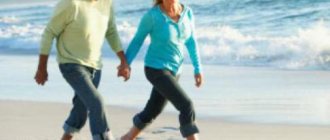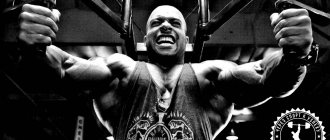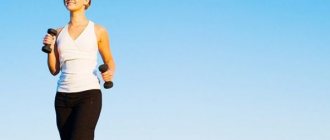- September 15, 2018
- Home workouts
- Nikita Novikov
Is it possible to pump your legs every day? This question is usually asked by beginners who are just about to sign up for a gym. If you are reading these lines now, then it is quite possible that you are one of them. In this case, we invite you to read our publication, which covers this topic in detail. After reading it, you will not only learn whether it is possible to pump your legs every day, but also understand on what principle it is necessary to draw up a training program. Interested? Then start reading quickly!
Stand strong on your feet
HOW TO PUMP UP YOUR SUPERLEGS
LEG PRESS
Most bodybuilders place their feet apart, but I have my feet close together and my toes pointing straight forward. This position works well on the sides of my quads and the ligaments between my hamstrings, glutes, and quads. Do the repetitions without stopping, and do not linger at the top point of the movement. Increase the weights according to the pyramid principle.
METHODOLOGY
In the first years of bodybuilding, I managed to “pump up” my legs. I remember that I then squatted until I completely passed out, until I collapsed, and did countless sets of 6-8 repetitions each. Of course, my legs grew quickly.
But, having become a professional, I began to understand that “mass” is not the main thing for a bodybuilder. Equally important are proportionality, symmetry and relief. Heavy basic exercises will no longer help here.
I had to reconsider my program and pay attention to each muscle individually
Advice!
This means that I switched to machines, increased the number of repetitions to 15-20, and switched to isolation movements, which are easier to control. But that is not all! Remember: success is impossible without constant development.
I am constantly making changes to my programs and discovering new possibilities for each muscle group. And for this you need to think all the time!
STANDING LEG BENDS
This simulator allows you to “pump” the semitendinosus at all possible angles, loading their external, internal, lower and diagonal parts. Keep your torso straight so that only your legs work.
LYING LEG BENDS
I do this exercise in my own way: I lift my upper body off the bench to better isolate the semitendinosus. Weight isn't that important here. The movements are slower, with constant muscle tension and at full amplitude.
STRAIGHT LEG DEADLIFT
LEG EXTENSION
Choose a weight that will allow you to strictly follow the technique at an average pace of movement. Keep your torso motionless so that the entire load falls on the quadriceps. Extend your legs using quadriceps force, not a swinging motion. I do repetitions without stopping or delaying at the top point and with each set I increase the weights according to the pyramid principle,
HACK SQUATS
I place my heels together and my toes apart. As I press the weight up, I don’t allow myself to lift my heels. Here I do not use the pyramid principle, but immediately set a weight that will allow me to do 15-20 full repetitions, and perform 4 sets with it.
| EXERCISE | SETS | REPEATS |
| Quadriceps | ||
| Extensions (warm-up) | 2 | 20-25 |
| Leg press | 6 | 15-20 |
| Hack squats | 4 | 15-20 |
| Leg extensions | 6 | 15-20 |
| Hamstrings | ||
| Standing leg curls | 3 | 15-20 |
| Lying leg curls | 3 | 15-20 |
| Deadlift on straight legs | 3 | 6-10 |
Kevin Levrone advises
Beginners do not have to train according to my complex, but you can stick to my split:
three days of training, one free.
Do four exercises for each body part for 4 sets and 10-15 repetitions.
For beginners, I would advise swinging only with dumbbells and a barbell.
At an advanced level, you can use exercise machines, but it is still better to give preference to barbells and dumbbells. The split remains the same: three working days, one free; For each body part, do four exercises from four sets, but reduce the number of repetitions to 10-12.
To ensure good blood flow to your muscles and protect them from damage, stretch each group before performing exercises and between sets.
Attention!
You should not increase the number of repetitions - this will lead to a decrease in load. On the contrary, your task is to make the workout more intense.
The more you load your muscles, the faster they grow; but you can only understand what intensity is through your own experience. Always think about your actions. Focus on working your muscles and try to cross the pain threshold.
A psychological attitude will help you overcome this threshold and find a second wind: find the reason why you vitally need to do one more repetition
It doesn’t matter what it will be - the main thing is to explain to yourself the need for action
Each of us has difficult days in life. Remember: sooner or later the black streak is sure to give way to white. The main thing is not to lose heart
It doesn't matter how long you have to wait. In any case, don't give up! And victory will be yours!
Basic rules for leg training
Before you start training your legs, you must do a preliminary warm-up; it’s better not to train your legs at all, if you forget about it.
To make it clear to everyone, the action plan is as follows:
⇒ 5 minutes of running exercises, exercise bike or orbitrek;
⇒ 1 set of squats with an empty bar (10-20 kg);
⇒ 2nd approach: performing squats with a weight of 50% of your working weight.
Only after completing these 3 points can you begin serious leg training. Beginners should pay attention only to basic exercises with a barbell and in simulators to hone the correct technique, and more advanced ones should additionally use a number of isolating exercises with dumbbells.
How many times a week should you go to the gym?
As you know, goals can be different. Let's start with something quite rare for girls - gaining muscle mass.
If you belong to the category of people who constantly lose weight, despite the fact that they try to eat a lot, then you are most likely in for heavy strength training with lifting weights. Heavy means that you will need to work with maximum effort.
In this case, the muscles and the body as a whole need time to recover - at least a day. That is why the classic involves training three days a week, when you work several muscle groups in one workout, then rest for a day and then train other muscles, and so on one more time.
So the training of all the muscles of the body is “broken” into three separate workouts and, conditionally, each muscle group rests for a whole week. This allows each muscle to recover well, which means it grows and becomes stronger.
I use the word “conditionally” because when training large muscle groups, smaller ones are always involved, respectively, for example, your triceps will work both when you train it purposefully and when you train the chest muscles.
If the training is moderate with light weight and is aimed more at tone, then one muscle group can be used several times a week. Just in this case, give each muscle group a rest for about 2 days. This means it can be 3, 4, 5, or 6 workouts per week.
If you work out in the gym according to the “full body” system, in which there is usually one, maximum 2 exercises with moderate load for each muscle group, then you can do it every day.
Let me sum it up. When strength training with weights, you need to give your muscles time to recover. To do this, you need to take into account the intensity of the workout. In general, if after a workout you can say “I’m tired, of course, but overall everything is fine,” then this is a moderate-intensity workout. If your thoughts are “I can’t do anything else even for a million,” this is definitely training at an increased difficulty and after it you need a break of 1-2 days.
Strength training options:
- distribute all muscle groups over three days, for example: legs/buttocks, chest/back, shoulders/arms
- for two days, for example: legs/buttocks/back, chest/shoulders/arms (in this case, each workout will be longer than with a three-day program)
- and yes, you can train 4, and 5, and 6, and even 7 days a week - the main thing is that all muscle groups have time to rest and, if yesterday you did a hard workout on a large muscle group, for example on the legs, then today is better train a smaller group, such as arm muscles or shoulders
- if this is a “full body” workout, you can do it every day
Example training program
As mentioned earlier, for people who train naturally, a three-day split is best. This system looks something like this:
- Monday: chest and biceps.
- Wednesday: back and triceps.
- Friday: legs and shoulders.
How often should you exercise your legs to grow? As you already understood, one hard and intense workout per week will be enough. Since the legs are a large muscle group, it takes a lot of time and effort to work them. If legs are a priority part of the body for you, then you can set aside a separate day for training them.
Pumping your legs
Most beginners, for about the first six months to a year, do not pay attention to their legs. And not only beginners, but also “semi-pros” are guilty of this. Usually, such people are called “beach people.”
They rock the top and don't care about their legs at all.
When they put on shorts or go to the beach, you can immediately see the inferiority of the “picture” and the lack of leg muscles immediately spoils the whole feeling of the rest of the “efforts”.
It’s worth remembering this and devoting at least one day of training to your legs. It is not difficult. What’s good about pumping your legs is that they can be pumped separately from all other muscles (if you don’t take into account the squat and deadlift). That is, while the “upper” is being restored, you can perfectly pump the lower part – the legs.
Important!
Moreover, it’s even pleasant to pump your legs. Despite their impressive volume, the leg muscles are also subject to the usual “killing”, they also hurt and recover.
They say that the legs recover quickly and can be exercised 2 times a week and even more if desired.
It's not difficult to pump up your legs. Usually, 3-5 exercises are enough. On the quadriceps, hamstrings, calves. These are muscles that form volume and shape. Exercises can be found in the “Muscle Map” section.
By giving your all in each exercise, you are guaranteed to achieve pleasant “burning” sensations in your legs, when it becomes difficult to walk, and the next day it also hurts. In my opinion, these are wonderful feelings that really make you feel great and continue to move and develop. After all, when your legs hurt, it always causes a special feeling, one might say, strength, power.
The secret that bodybuilders hide
It is possible that people who are interested in how often per week to work out their legs and buttocks were surprised when reading the above information. It is quite possible that someone even objected: “But Arnold Schwarzenegger trained every day, that’s why he achieved such impressive results in bodybuilding!” This is true; Arnold, like all professional bodybuilders, practiced daily training. But you should understand that experienced bodybuilders use dangerous anabolic steroids, which increase endurance several times and stimulate muscle growth. Also, if you think that they were training every day all the time, then you are very mistaken. As a rule, they resorted to such intensive training only 3-4 weeks before the competition.
How to quickly pump up your legs Or my experience of pumping up your legs in 6 Workouts of 30 Minutes each. All about Bodybuilding
Before moving on to the article, I would like to draw your attention to this service for athletes. Virtual rocking chair is just a godsend for beginners
All the advanced training principles are so organically and competently woven into the training programs that I regret that such a service did not exist when I myself was a beginner.
You don't know how quickly you can pump up your legs? Then read my experience of pumping up legs at an accelerated pace.
There are actually a lot of exercises for pumping up muscles, and I will now tell you which of them is the most effective.
First, I want to tell you my story and from it you will understand everything...
It is important!
The first two years of my training, I absolutely did not touch on pumping up the leg muscles, I only pumped up the torso, because that’s all I saw in the mirror and didn’t think about the fact that legs are also very important for a bodybuilder.
And somehow I decided to really take up training the leg muscles, but I still didn’t know what exercises to do, and there wasn’t much choice of exercise equipment. Only one rod with racks was at hand.
I often heard at that time that legs can be pumped up very well with squats. I had no choice, I started doing squats... Although fitness with a pool remained in my dreams.
After the first workout, I realized that squats are a very effective exercise for quickly pumping up leg muscles, since after it, almost all the muscles in my legs hurt for about a week.
I continued to squat. My leg training took place only once a week on Sundays and lasted only 30 minutes. I only did one squat and did nothing else during my leg workout.
I began to notice that the muscles were actually growing at an unprecedented pace, and so 6 weeks and only 6 workouts passed.
And somehow, after the 6th workout, I decided to wear jeans, which I had calmly walked around in before and they were just right for me. And what do you think?
I not only couldn’t fasten them, but I couldn’t even put them on at all; they were simply bursting at the seams. After I went to the store and bought new jeans, it turned out that I now needed pants 2 sizes larger than I was wearing before!
I made the following conclusions about quickly pumping up my legs:
- Since I pumped my legs only once a week, they had time to fully recover in 7 days;
- Since I was completely focused on pumping up my legs, all my strength in training went only to them;
- Squats are an excellent mass-gaining exercise for the legs and you can’t argue with that;
Here is a completely real story about how you can quickly pump up your leg muscles without any tricks while doing just one basic exercise.
I wish you not to forget about the base and periodically pump your legs to give your body a harmonious look!
And in conclusion, I want to advise you - squat, squat and squat again if you want to have beautiful and powerful legs, because this is the best basic exercise for pumping up your legs.
Helpful advice!
You may also be interested in the article: fitness club subscription price, read it here or material on the topic “sports nutrition for gaining muscle mass”
Results
Is it possible to pump your legs every day? Let's summarize all of the above to give a final answer to this question:
- The legs are a large muscle group that takes a long time to recover. It follows that it does not need to be trained more than once a week.
- It makes no sense to train like professional bodybuilders because they use steroids.
- The best training regimen for a natural is a three-day split.
- The training session should last no more than 60 minutes.
- If legs are a priority for you, you can train them on a separate day.
Now you know whether it is possible to pump your legs every day.
How to choose leg exercises
Trainers often say that slender legs are impossible without basic exercises - squats for the front of the thigh and deadlifts on straight legs for the hamstrings, but this is not always the case.
— If you just need to polish your figure, then you need to perform various swings, fly-outs in simulators, and so on. That is, if a girl initially has a good figure, with good genetics, and she just needs to remove excess in some places, then she does not have to do squats or deadlifts, says Eduard Belonozhko.
So, let's leave barbell squats and straight-leg deadlifts for more advanced girls, and consider simpler and more effective exercises for losing weight in legs.
Swing your legs
One of the simplest leg exercises that can be performed even at home - standing or lying down. But it will still be more effective to perform it in the gym in a crossover with light weights. Swings can be performed in three variations: forward, backward and to the side - it depends on which part of the leg we want to load. For the most effective development, you can combine all three variations into a complex and perform 15 swings of each type in turn without rest.
Photo: eastnews.ru
Lunges
You can perform lunges either without weight or with any weight, be it a barbell or dumbbells - all variations are effective. When lowering, the body must be kept straight and not leaned forward. The knees at the bottom point of the movement should not go beyond the toes, that is, you need to squat as deeply as possible. You need to push yourself up without the help of your back leg.
Photo: eastnews.ru
Leg curls in the simulator
A great isolation exercise for the hamstrings. When performing lying bends, your knees should hang slightly off the bench, the roller should rest against the back of your ankles or slightly above, and your body should be pressed tightly against the bench so that your back is not involved in the work.
Leg extensions in the simulator
An exercise aimed at working the front surface of the thigh. Extensions will not only help burn fat, but will also give definition to your legs; to do this, try to hold for 1-2 seconds at the top point.
Photo: eastnews.ru
Breeding and mixing in the simulator
Perhaps the most popular women's exercise machine, which allows you to work out not only the outer and inner thighs, but also the buttocks and even the abdominal muscles
It is important to perform the movement as smoothly as possible and, again, with a slight delay at the point of peak load
Photo: eastnews.ru
Leg raises
Another exercise for losing weight on your legs, suitable for home workouts. Lying on your back, slowly raise your straightened legs to an angle of 90 degrees. At the same time, the lower back should not come off the floor, otherwise the exercise will involve the abs more than the legs.
Photo: eastnews.ru
Pelvic lifts
An excellent home exercise for firm gluteal muscles. Lie on your back with your knees bent and your legs pressed together. Pressing your heels and shoulder blades into the floor, we lift your pelvis up as high as possible. At the top point you need to linger for 1-2 seconds for maximum contraction of the buttocks.
Photo: eastnews.ru
In addition to exercise, running or cycling will help you get rid of fat in your legs. Cardio training can be done at least every day; unlike strength training, the body and muscles will not take much time to recover. In addition, relaxing baths, swimming and foot massage performed at night will be beneficial in losing weight.
News smi2.ru
Leg training in the gym. Set of 6 exercises
Start regular bodyweight squats
Squats are an undeniable exercise to start your leg day. Why? Let's count the benefits. Squats max out your leg muscles, you can do them with heavy weights, they work your entire lower body (and more than half your upper body), and studies show they increase the release of muscle growth hormone better than any other movement.
Squats are actually a group of exercises that involve hip and knee movements. There are many variations, all of which have their own value. Some differ in the placement of the barbell, others in the type of equipment used, and still others in the placement of the legs.
You can start your day at the gym with barbell squats or a variation of the single-leg squat. We will perform an exercise - squats with a barbell on the shoulders, for this we will need a high power rack with a bar. We place it at a height just below the shoulder girdle. This variation is preferred by most bodybuilders because it hits the leg muscles fairly evenly, and because you can squat heavier than other variations of the exercise.
The most common recommendation is to squat to at least the point where your thighs are parallel to the floor, but honestly, this varies from person to person and depends on their flexibility. No matter how deep you squat, it is important that your spine remains straight and never flexes (rounded), which can cause dangerous damage to the discs.
Solution: Work on your flexibility; Stiffness in your thighs and calves can also affect the depth of your squats. The time you put into technique will pay off in greater performance; a deeper squat is always a better squat.
Execution method
Do several warm-up sets, increasing the weight each time, but never approach failure while warming up. Most workouts require a range of 8 to 12 reps - this is the sweet spot for muscle building, but in the first few working sets of your leg workout, when the strength level is huge, choose heavier loads. So instead of choosing a weight where you fail at about 8 reps, go for a heavier weight for a set of 6 reps. This will give you a little more incentive to build strength.
“A set of exercises for the leg muscles” - read the link
Do another squat variation, adjusting the intensity and angle
No, now is not the time to use exercise equipment. In this leg program, you won't even go near the machines until the end of the workout.
We still emphasize knee and hip movement, and your best choice is probably the one that is your least favorite and therefore most difficult exercise. Most powerlifters are a little behind in quad development, so the front squat is a staple in their leg program.
Simply changing the position of the barbell from behind the head to the front changes the distribution of load across the lower part of the muscles. This puts more stress on the quads than on the glutes and calves, and means that the weights need to be reduced. The movement also requires you to hold a more frontal position, which can be safer for your back and also allow you to squat deeper.
Execution method
Since you've already done some serious strength work with sets of 6, consider a lighter weight that you can do for sets of 10-12 reps. You'll be working slightly different muscle fibers while still giving them the stimulus to grow.
Add load to the hamstrings
The straight-legged barbell row is an ideal exercise for the hamstrings after performing squats. This exercise targets the upper hamstrings and glutes, is unlike other single-joint movements, and is actually quite effective. Plus, most hamstring exercises focus on curls (which work through the movement of the knee joint), while this is done with hip curls, which is underappreciated by most personal trainers. And perhaps another benefit is the break from routine in your leg training program.
But as with most compound movements, the key is to not do it incorrectly, which can only cause harm. When performing deadlifts, you must always keep your spine straight and keep the barbell close to your shin. Even if it’s hard for you to perform the full range of motion and lower the barbell to the floor while keeping your back straight, it’s not a problem, that’s not the point of the exercise. Just get a good stretch by lowering the bar as far as you can and return to the starting position.
Learning proper movement technique is a must, so start training with light weights. Once you have mastered the range of motion, begin to increase the weight, but always be careful to keep your back straight.
Execution method
Once you master the movement, you will be able to lift the barbell with a very good weight. After warming up, do 2 heavy sets of 8 reps and 2 light sets of 12 reps.
“A set of exercises for the buttocks” - read the link
Add a one-way movement to work the legs separately
Now that you have heavy bilateral work in the back, it's time to work each leg individually. The Bulgarian squat, where you lock your back leg onto a bench behind you, is an ideal choice. Raising the back leg forces the front hip, especially the quadriceps, to take on more of the workload and also engage the glutes of that leg. If balancing is too difficult at first, you can do double squats or lunges. As a last resort, you can do this in a Smith machine.
If you think that the Bulgarian squat is a weak and ineffective exercise, it is not. On the contrary, this is the main arsenal in the leg program. According to research, some EMG data shows that 4 sets of 10 reps to failure of the Bulgarian squat is not much different from the barbell squat. The same study also found similar testosterone releases in Bulgarian and barbell squats.
Execution method
You won't be able to use much weight with this movement, even if you have plenty of strength left from other exercises. Do 3 sets of 10 repetitions on each leg alternately.
Add Volume by Training for a Pump
You can't build big legs using only machines, so the leg press exercise is not at the top of our program. But the machines are ideal for increasing the volume of your workout after your thighs are already burning and when it becomes difficult to maintain balance and good tone.
Moreover, you can adjust the placement of your feet on the platform of the apparatus to change the focus of tension. A high stance hits the glutes and hamstrings more, while a low stance focuses the tension on the quads. As before, a deep range of motion involves more work in the buttocks and hamstrings.
Since this part of the workout is about pumping the muscles as much as possible, light weight sets are more appropriate here than with squats. Pampig stimulates hypertrophy by delivering blood to the muscles, a different growth mechanism is activated than with the loads created by heavy squats at the beginning of this leg program.
Execution method
Mentally set yourself up and start working on your thighs. Do 3 sets of 10 to 12 reps, doing a drop set on the last set to increase the burn.
“A set of exercises for the back” - read the link
The last exercise is the lying leg curl.
The hamstrings are antagonistic to the quadriceps, so they need to be supplemented with work to match the front of the thigh.
A leg movement that better accentuates the lower hamstrings in the area above the knee is also a good addition to an upper-focused leg program. This is a good pump exercise and is the perfect finish before heading to the locker room.
Execution method
Finish this leg program by doing 3 sets of hamstrings, finishing with a drop set like the leg press.
Why you can't exercise every day
Until recently, trainers and doctors agreed that each day of training should focus on only one muscle group. Today we had to move away from this method, as it turned out that the athlete simply did not have time to recover in such conditions. Daily exercise had a detrimental effect on the body as a whole. The nervous system could not cope with frequent stress. The effect of training decreased, and the athlete experienced the effects of overtraining.
There are various supplements with which the body can restore strength much faster, but daily use of such substances can have a bad effect on health.
The time for normal, but incomplete muscle rest is usually within 3 days. This figure varies greatly depending on experience. Beginners may need a whole week. Also, a lot depends on the muscles themselves. So, large ones require a long recovery, small ones, accordingly, rest faster.
For example, the legs, which occupy about 50% of the total muscle mass of the body, should not be frequently loaded. Hands correspond to 25%, so they need 2 times less time to recover. The biceps, triceps and shoulders should be trained more often than others, but they are often used when working on larger muscles.
Therefore, it is important to take into account the indirect participation of one or another muscle group
Number of workouts
How many should the number of visits to the gym per week be for beginners and amateurs? Those who have recently decided to get a pumped up body should stick to the “1 day of training/2 days of rest” scheme. But provided that the loads correspond to the level, and after training you will feel tired. If such a frequency of classes no longer causes any particular difficulties, then you should move on to the amateur stage, the number of classes will increase up to 3-4 times.
For those who want to lose weight, the number of workouts can vary greatly. The fact is that when losing excess weight, cardio exercises are a priority, and they can be performed daily without harm to health. But you should not exercise forcefully, since exercising with excess weight is much more difficult, and in addition, there is a possibility of a sharp deterioration in the condition. Therefore, before starting intensive weight loss, you should consult your doctor.
If you use strength exercises, then the weight may, on the contrary, increase, since muscle mass will build up, which will not contribute to the destruction of fat. Therefore, you should switch to such exercises only after losing a few kilograms thanks to cardio exercises.
- Our external appearance and physique largely depend on genetics. Some gym goers may not watch their diet at all...', 270);” onmouseout=”hidettip();”>Determination of body type in men
- In all types of physical activity, the principle of moderation should be observed. The expression “the slower you go, the further you go” is very relevant here. Man, occupying...', 270);” onmouseout=”hidettip();”>How often should you exercise
- The deadlift is one of the most popular and effective basic movements, putting an incredible load on almost all muscle groups, but more...', 270);” onmouseout=”hidettip();”>What muscles work when deadlifting
- Push-ups are considered one of the basic exercises designed to build a strong muscle and strength foundation for the upper body using only...', 270);” onmouseout=”hidettip();”>What muscles work when doing push-ups?
How to pump up muscles
Instructions
Beginners often have a desire to take the maximum weight at once and do a large number of approaches. Be careful not to overdo it, as this may cause injury.
Perform each exercise carefully, while feeling the work of a specific muscle group. Start with squats, push-ups and pull-ups on the horizontal bar.
Stretching exercises can increase muscle strength and make them more elastic.
The first rule is that the nature of the load should be aerobic. Select the weight of the weight so that you can perform only ten to fifteen exercises at the limit of your capabilities. If you press the barbell forty to fifty times, you will only train endurance, but not build muscle.
The next rule is to constantly change the nature of physical activity.
The nervous system and muscles quickly adapt to loads and stress, so make periodic changes to your training regimen: change the speed of the exercise, the rest time between sets and rest, the number of days between workouts, combinations and exercises, the number of approaches and the priority of performing movements. Do not let your muscles adapt to the load; there must be a constant struggle here.
The training time should not exceed sixty minutes (preferably forty to fifty minutes). A longer workout will only drain all the energy from you, and, as you know, it is not endless. When the liver cannot supply energy, a mechanism is used to release energy from the muscle tissue junction. Therefore, long-term training can destroy the muscles that you have worked on for so long.
When visiting the gym, be sure to check with the instructor on how to properly pump up your muscles using this or that exercise machine. Familiarize yourself with the exercise technique.
Helpful advice!
To begin with, limit the number of approaches to two, and after the muscles get used to the load, experiment with the number of approaches.
To gain muscle mass, a balanced diet will come to your aid.
